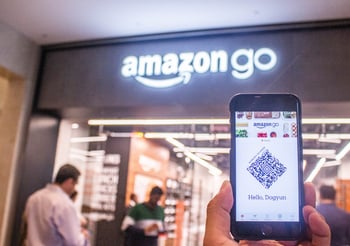E-commerce is an ever-evolving transaction, shifting and expanding to fit consumers’ needs and tastes. E-commerce is constantly growing, but it doesn’t have to be difficult to keep up with. The key is to pay attention to online shopping trends and adapt your business operations accordingly.
The Latest Product Trends in E-commerce
With such a saturated online market, many e-commerce brands are looking for new ways to stand out from their competition. Here we share e-commerce trends to be on the lookout for this year and how they can benefit your business.
Visual Commerce: Enhance the reality of online shopping
 Visual commerce involves more than standard JPEGs and other static visuals. Rather, visual commerce includes a range of multimedia including interactive content, augmented reality (AR), videography, and even QR codes.
Visual commerce involves more than standard JPEGs and other static visuals. Rather, visual commerce includes a range of multimedia including interactive content, augmented reality (AR), videography, and even QR codes.
Capturing the attention of an audience is not an easy feat. In fact, 79% of web users scan a page, with a mere 16% actually reading the page’s content. Plus, over half of web users spend 15 seconds or less on a page. Visual commerce can grab and hold the attention of your audience by improving product discoverability.
Here are a few key features to be aware of when it comes to visual online shopping trends:
- 360-degree images or videos
- High-resolution visuals
- Interactive visuals
- Visual search tools
- QR codes
Customers may feel hesitant to purchase products online since they can’t physically interact with them. Visual commerce allows customers to interact with products while online shopping and makes products seem more familiar. It’s becoming more and more imperative to have a variety of visual options for customers so they get the full experience of a particular product, heightening their engagement.
Artificial Intelligence: Personalize the shopping experience
 Artificial intelligence (AI) and machine learning have made it easy for customers to experience personalized shopping experiences. AI predicts customer shopping patterns based on accumulated browser and shopping history. Then, it creates specific algorithms to show products customers are most likely to be interested in purchasing. This allows consumers to navigate the buying process with more specificity and ease.
Artificial intelligence (AI) and machine learning have made it easy for customers to experience personalized shopping experiences. AI predicts customer shopping patterns based on accumulated browser and shopping history. Then, it creates specific algorithms to show products customers are most likely to be interested in purchasing. This allows consumers to navigate the buying process with more specificity and ease.
Consumers are looking for personalized shopping experiences to enhance their brand experience. One study found that companies could experience a 25% boost in revenue with personalized experiences. AI bridges the gap between consumer and product and enhances the space for consumers to feel seen, and reflected, in their personal tastes and needs.
Chatbots: Help make the sale
 Chatbots interact with online consumers the way in-person sales associates would in a traditional brick and mortar store. They benefit businesses in a variety of ways, such as lessening the load on customer service teams and saving company’s both time and money.
Chatbots interact with online consumers the way in-person sales associates would in a traditional brick and mortar store. They benefit businesses in a variety of ways, such as lessening the load on customer service teams and saving company’s both time and money.
Chatbots can perform a variety of tasks, such as:
- Facilitate surveys and collect data
- Provide information about products and services
- Encourage consumers to follow through with purchase
With advances in technology and intelligent learning, chatbots are becoming more intuitive when it comes to interpreting a customer’s unique needs and providing a solution. This improves the user’s experience tremendously. With chatbots, customer service can be available 24/7, facilitate live communication that is seamless, and provide a customer with a smoother journey toward a purchase.
Social Media: Reach customers in their everyday life
 Social media has transformed the way we work, shop, and live. However, newer apps such as TikTok have completely revamped online shopping trends. Millennial and Gen-Z markets specifically have turned to make purchases off of apps like TikTok, Instagram, and Twitter. Furthermore, the social commerce market is expected to grow by almost 30% by 2028.
Social media has transformed the way we work, shop, and live. However, newer apps such as TikTok have completely revamped online shopping trends. Millennial and Gen-Z markets specifically have turned to make purchases off of apps like TikTok, Instagram, and Twitter. Furthermore, the social commerce market is expected to grow by almost 30% by 2028.
On apps like Instagram, users can purchase from businesses without ever leaving the app. Other social apps like TikTok and Twitter will often have videos advertising specific products, links to a product’s homepage, or call-to-actions encouraging users to purchase specific products.
It’s important to tap into these markets, and learn how to engage newer audiences that may not interact with traditional email or PPC marketing.
Grow Your Business with SellerActive’s E-commerce Solutions Services
 Building and syncing listings across multiple online marketplaces is a time-consuming challenge. Save time and energy with SellerActive’s multichannel management software that helps you list and update your products from a single location.
Building and syncing listings across multiple online marketplaces is a time-consuming challenge. Save time and energy with SellerActive’s multichannel management software that helps you list and update your products from a single location.
With SellerActive, we help give you time back in your day by streamlining the process and making it simple. We partner with top online selling platforms like Amazon, Walmart, and eBay. Learn more about our inventory management services and sign up for your 30-day free trial today!